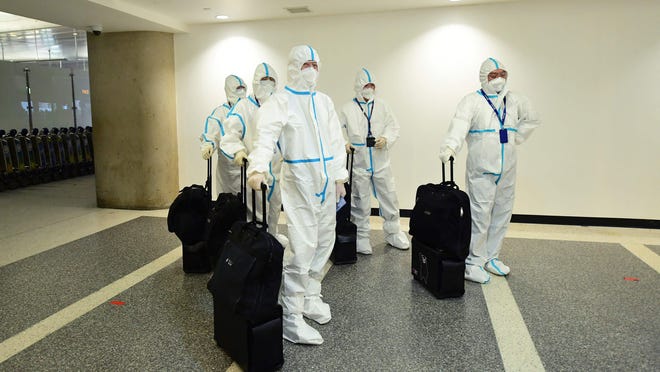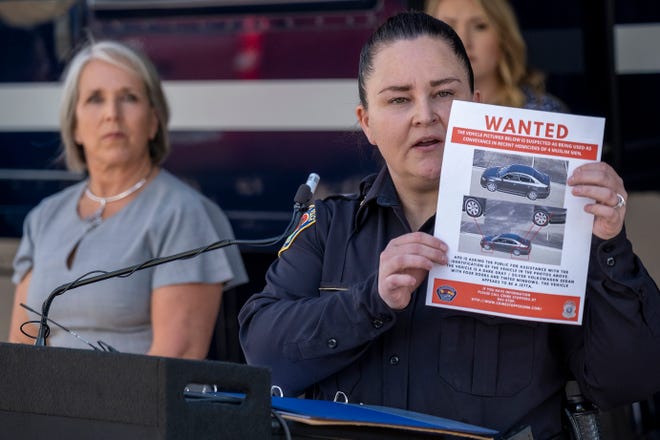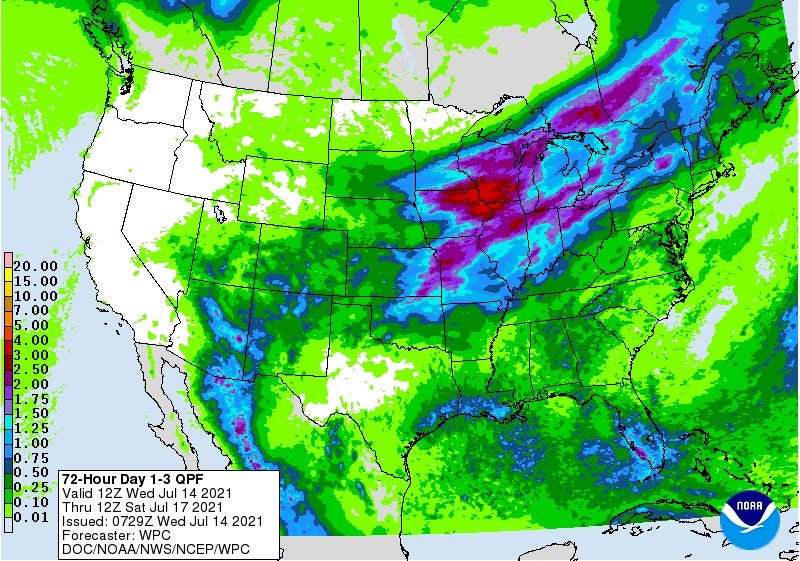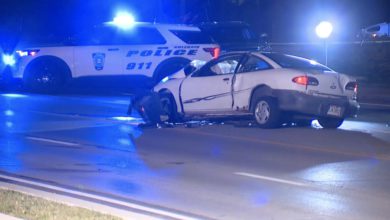
The United States is averaging more than 300,000 new reported coronavirus cases per day for the first time, although hospitalization numbers are somewhat less gloomy.
A USA TODAY analysis of Johns Hopkins University data shows the country reported 2.11 million cases in the seven-day period ending Wednesday, an increase of 82% over the previous week as the omicron variant, holiday gatherings and frenzied testing helped push numbers higher.
Forty-seven states show rising case counts and 15 states reported their highest-ever counts: Connecticut, Delaware, Florida, Georgia, Hawaii, Illinois, Maryland, Massachusetts, New Jersey, New York, Ohio, Pennsylvania, Rhode Island, Virginia and Washington and Puerto Rico.
The national pace of hospital admissions for likely COVID-19 patients was up 20.7% from a week earlier, alarming but far lower than the jump in infections. Experts say early data indicates omicron might not be as severe as previous variants. That and the rise in vaccinated Americans have had an impact – the number of Americans now in the hospital with COVID-19 is running at around 65,000, or about half the number in January, the Centers for Disease Control and Prevention reported.
And Dr. Anthony Fauci said the average stay during the current surge at a major South African hospital is about four days, down from 8.8 days in previous surges. The numbers are similar to other preliminary reports, Fauci said.
"The pattern and disparity between cases and hospitalization strongly suggests that there will be a lower hospitalization to case ratio when the situation becomes more clear," Fauci said.
Also in the news:
► Michigan’s health department said it's not ready to join the CDC in reducing isolation restrictions for people infected with the coronavirus from 10 days to five. Officials said they will first review supporting evidence for the CDC's guidance.
►The University of Miami will start the spring semester Jan. 18 with remote-only classes. School President Julio Frenk, president of the private university, said in-person classes are expected to resume on Jan. 31.
►The Weatherford Hotel in Flagstaff, Arizona, won't be dropping its giant, lighted metal pine cone this New Year's Eve. The annual event, which draws thousands to downtown, was canceled because of public health concerns.
► The world set a new record for cases Wednesday – 1.73 million reported in a day – bringing case counts to 7.33 million for the seven-day period, the first time the average has been above more than 1 million per day. Global case counts are up 48% from the previous week.
📈Today's numbers: The U.S. has recorded more than 53.7 million confirmed COVID-19 cases and more than 822,000 deaths, according to Johns Hopkins University data. Global totals: More than 284.9 million cases and 5.4 million deaths. More than 205 million Americans – 61.9% – are fully vaccinated, according to the CDC.
📘 What we're reading: Next month, Americans will be able to request free tests from a website, and kits will be mailed to homes. The website, and other details about how and when the tests will be distributed, have not been released. Experts urge that insurers work with pharmacies to make the tests free to consumers up front.
Keep refreshing this page for the latest news. Want more? Sign up for USA TODAY's free Coronavirus Watch newsletter to receive updates directly to your inbox and join our Facebook group.
Almost 50,000 flights canceled or delayed since Christmas Eve
Thousands more U.S. flights have been canceled or delayed Thursday, according to FlightAware, which tracks flight status. There have been more than 8,000 cancellations and more than 39,000 delays within, to or from the U.S. since Christmas Eve. In a perfect storm of circumstances, between inclement weather and another coronavirus wave, travel industry experts expect the holiday travel season to come to a bumpy end for customers, and winter is just beginning. Read more here.
"We look at flights but see, the thing is they're connected to people," said Captain Dennis Tajer, an American Airlines pilot and spokesperson for their pilots union, Allied Pilots Association. "For each one of those passengers, there may be five to 10 family members and friends that were counting on them being at the holiday table."
– Eve Chen
NYC going forward with ball-drop in Times Square
New York City is forging ahead with modified plans for its annual New Year's Eve ball drop in Times Square on Friday despite record numbers of COVID-19 cases across the city and nationwide. In 2020, revelers were banned from the celebration as a result of the pandemic, and only essential workers, media members and police were at Times Square as the ball dropped. This year, the city will require revelers to show proof of vaccination and photo ID and to wear masks. The event normally hosts 58,000 people, but this year will be limited to about 15,000 attendees and won't allow entry until 3 p.m. ET, de Blasio announced last week.
"We want to show that we’re moving forward, and we want to show the world that New York City is fighting our way through this," Mayor Bill de Blasio said Thursday on NBC's TODAY Show.
– Christine Fernando
Ohio has nation's highest COVID hospitalization rate
The number of people in the hospital with COVID-19 has reached a pandemic record high in Ohio, and Gov. Mike DeWine has ordered additional members of the state National Guard into hospitals to help with the surge. Ohio had 5,356 people in the hospital with the coronavirus Wednesday – the highest per-capita hospitalization rate in the country, said Robert Wylie, chief medical operations officer at the Cleveland Clinic. More than nine of every 10 people hospitalized with COVID-19 since June have been unvaccinated, DeWine said.
“If you’re vaccinated, the chances of you ending up in the hospital are pretty darn slim,” he said.
Michigan teacher tests positive on plane, isolates in bathroom for 5 hours
A Michigan school teacher traveling over the holidays voluntarily isolated in an airplane's tiny bathroom for five hours after testing positive for COVID-19 mid-flight. Marisa Fotieo was on a flight to Iceland from Chicago on Dec. 20 when her throat began to hurt, TODAY reported. With rapid test kits handy, Fotieo decided to take one "and within what felt like two seconds" discovered she was positive for the virus. She filmed what it was like to quarantine in the tiny quarters in a video that drew over 4 million views on TikTok. She later isolated again at the Red Cross hotel in Iceland.
"There’s 150 people on the flight, and my biggest fear was giving it to them," she told TODAY.
– Asha C. Gilbert
Shorter isolation time draws mixed reviews
Federal officials are defending the Centers for Disease Control and Prevention's decision to cut to five days – from 10 days – the amount of recommended time people should isolate after testing positive for the coronavirus. Some have rejoiced in the shortened isolation period, while others have criticized the decision, arguing the CDC turned its back on science and bowed to business interests.
The announcement came days after Delta Airline's CEO publicly asked the CDC for a shorter isolation period, and in the midst of thousands of canceled flights, which airlines have blamed on staffing shortages because of the latest surge in coronavirus infections.
CDC Director Rochelle Walensky said the new recommendation is backed by science. The most amount of COVID-19 transmission happens in the one or two days prior to developing symptoms and in the two to three days after developing symptoms, Walensky said – totaling five days. The decision is backed by behavioral science, too, she said.
“It really had a lot to do with what we thought people would be able to tolerate,” Walensky told CNN's Kaitlan Collins.
Some professional associations have pushed back on the new guidelines, saying they'll be harmful to workers. The American Nurses Association urged the CDC to reconsider its decision, saying guidance "is especially problematic when reliable testing is not widely available, and particularly difficult to access in places experiencing surge conditions."
Fauci: Cancel your large New Year’s plans with ‘hugging and kissing’
Dr. Anthony Fauci, the nation’s top infectious disease expert, warned Americans to stay away from large-scale New Year’s parties and opt for small gatherings with vaccinated and boosted people.
“If you were in a situation with a family setting, in your home, with family – parents, children, grandparents – and everyone is vaccinated and boosted, although the risk is never zero in anything, the risk is low enough that we feel you should continue to go through with those plans,” Fauci said during a news briefing Wednesday.
Cities around the world have canceled their large New Year’s Eve celebrations amid the rapid spread of the omicron variant of the coronavirus. New York City put an attendance cap of 15,000 on its annual Times Square party and will require proof of vaccination. Events in Los Angeles and Seattle have also been canceled.
“If your plans are to go to a 40- or 50-person New Year’s Eve party with all the bells and whistles and everybody hugging and kissing and wishing each other a Happy New Year, I would strongly recommend that this year we do not do that,” Fauci said.
Key to reopening schools: Testing
In anticipation of steep challenges reopening schools amid an omicron-driven surge of infections, districts are planning to ramp up COVID-19 testing when classes resume in January. New testing strategies come as COVID-19 infections and pediatric hospitalizations have shot up in a handful of states, especially in the Northeast. With a record number of cases, even among fully vaccinated individuals, school leaders are worried not only the health of staff and students, but also about the ability to stay open if too many employees fall prey to illness or quarantine. Read more here.
"We are moving closer to a safe reopening of school next week," Michael Mulgrew, head of the United Federation of Teachers in New York City schools, said. "But we are not there yet."
– Erin Richards
Tested positive for COVID during the holidays? Here's what to do.
Testing positive for COVID-19 starts a confusing, disruptive and at times frightening process – one that millions of Americans will likely go through in the coming week.
First, you need to isolate. That’s a more intense version of quarantining – it means cutting off contact with other people as much as possible so you reduce the chance of infecting them. This also means forgoing travel, not going to work and even limiting contact with people in your own household who aren't infected.
The CDC says isolating is a necessary step whether you’re vaccinated or unvaccinated, and whether you have symptoms or feel fine.
Everyone who tests positive for COVID-19 should monitor their symptoms. And people who are unvaccinated or at high risk for severe disease should be extra-vigilant for symptoms that might require emergency care. Call your doctor for early treatment options.
How long should you isolate? How long will I be contagious? What if you are in close contact with someone who tested positive? Here’s what you should know about omicron and COVID-19 this holiday season.
Contributing: Mike Stucka, USA TODAY; The Associated Press
Source link










